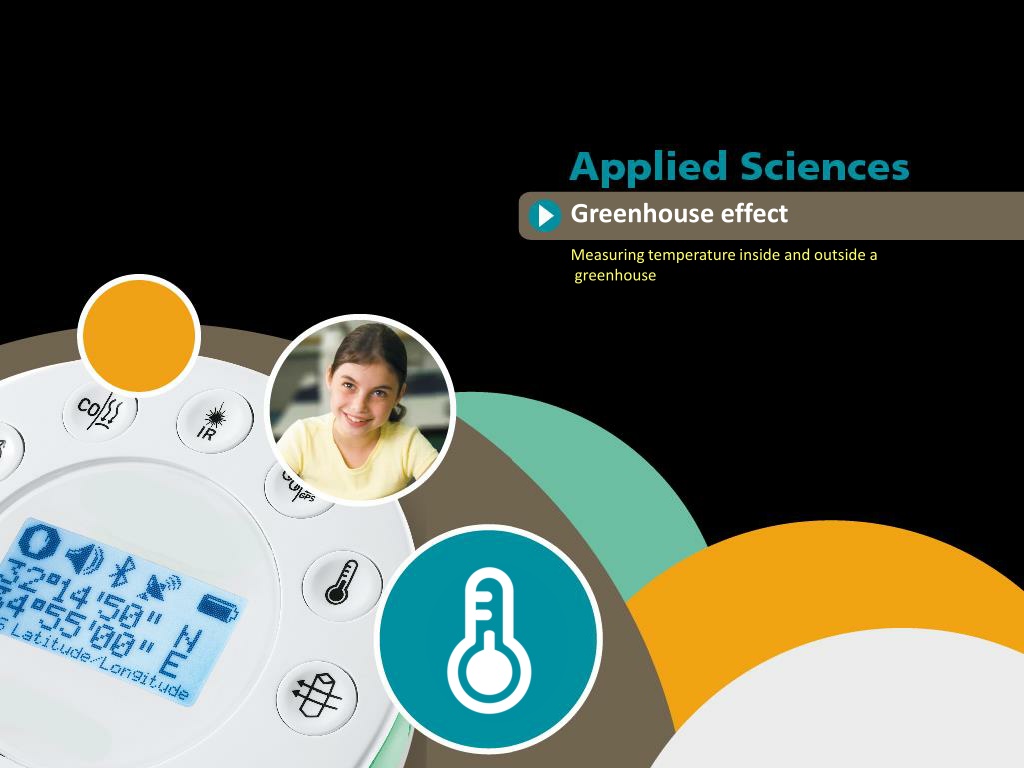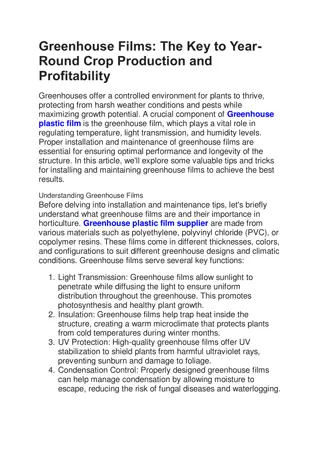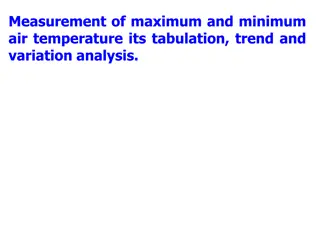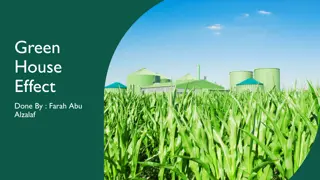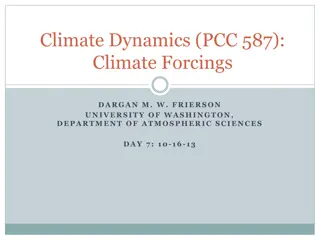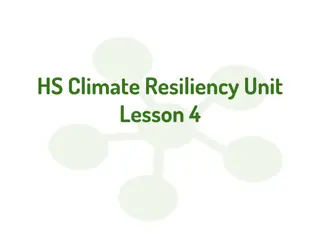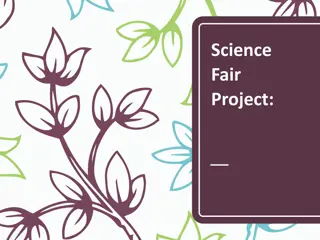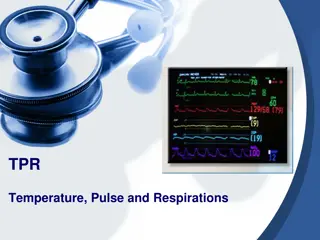Understanding the Greenhouse Effect: Measuring Temperature Inside a Greenhouse
Explore the concept of the greenhouse effect by studying temperature variations inside and outside a greenhouse. Learn about the impact of sunlight radiation on temperature levels, the importance of greenhouses in agriculture, and the similarities between a greenhouse and the Earth's natural greenhouse effect.
Download Presentation

Please find below an Image/Link to download the presentation.
The content on the website is provided AS IS for your information and personal use only. It may not be sold, licensed, or shared on other websites without obtaining consent from the author. Download presentation by click this link. If you encounter any issues during the download, it is possible that the publisher has removed the file from their server.
E N D
Presentation Transcript
Greenhouse effect Measuring temperature inside and outside a greenhouse
Greenhouse effect Measuring temperature inside and outside a greenhouse Objective The purpose of this activity is to study the difference in temperature inside and outside a greenhouse, to create a hypothesis which will be tested during an experiential activity using the SensorLab s external temperature sensor.
Greenhouse effect Measuring temperature inside and outside a greenhouse Introduction and theory The aim of the introduction is to focus students on the lesson subject by refreshing acquired knowledge and asking questions which encourage research development. Key concepts from the theoretical framework, applied by the students during the lesson, are taught. Introduction In some places of the world it is usual to build plastic or glass buildings to protect vegetables or flowers during cold seasons. These buildings, called greenhouses, cause a rise in their internal temperature, which is good for the different species of plants that grow there. Increase in temperature is caused because sun radiation enters, but only a small part can leave the greenhouse once it has been reflected or absorbed. This is similar to the process that occurs on Earth causing the atmosphere to warm-up and enabling the existence of life on our planet.
Greenhouse effect Measuring temperature inside and outside a greenhouse Introduction and theory In which places of the world do you think greenhouses are used? Do you think there is a relationship between what happens in a greenhouse and global warming? At the end of this class you will be able to answer following question and investigate! Why do agronomists use greenhouses?
Greenhouse effect Measuring temperature inside and outside a greenhouse Introduction and theory Theoretical A greenhouse is a metal or wooden structure covered with different types of translucent material, like plastic or glass. This kind of material is used because sun radiation is able to pass through it but can t leave once it is inside. This process causes a rise in air temperature inside the greenhouse, because infrared radiation (the part of the spectrum with the most thermal energy) coming from the sun reflects off the floor and sides and stays inside. This phenomenon is called greenhouse effect.
Greenhouse effect Measuring temperature inside and outside a greenhouse Introduction and theory On the Earth surface, the same phenomenon occurs at greater magnitude. The natural greenhouse effect keeps the Earth s climate warm, allowing the existence of life, in a similar way to a greenhouse. In our atmosphere the greenhouse effect is caused by greenhouse gases, like methane (CH4), carbon dioxide (CO2) and water vapor (H2O). Sun radiation comes into contact with the surface of Earth, warming it. Heat is then radiated towards the atmosphere where it is stopped by greenhouse gasses preventing it from leaving again towards outer space. Heat then flows between the external atmospheric layer and the Earth s surface, keeping peak temperature conditions for life existence.
Greenhouse effect Measuring temperature inside and outside a greenhouse Introduction and theory The greenhouse effect happens at a given concentration of greenhouse gases. In recent years the amount of greenhouse gases has strongly increased due to human industrial activity. For example, carbon dioxide emanation from industrial processes enhances the natural greenhouse effect, causing further temperature increase. This phenomenon is called global warming.
Greenhouse effect Measuring temperature inside and outside a greenhouse Introduction and theory Global warming is a concept that refers to the rise in average global atmospheric and sea temperature. Scientists are aware of the periodic return of high-temperature cycles on Earth. At the beginning of the 19th century a significant increase of greenhouse gases occurred related to the industrial revolution. During this period the combustion of fossil fuels like coal and oil as energy sources caused an increased greenhouse gas release.
Greenhouse effect Measuring temperature inside and outside a greenhouse Introduction and theory As a result the Earth s surface has continuously risen in temperature. This rise in average temperature reaches actually around 8 C . Some consequences of this are the melting of the poles, the rise in sea level and other problems like an increase in hurricane, tornado and storm frequency, hotter summers and colder and longer winter seasons. Students are now invited to create a hypothesis according to the following question. Explore previous concepts during the class so that you ll be able to answer! If we expose a small greenhouse to the sun, how many degrees will the variation in temperature inside be?
Greenhouse effect Measuring temperature inside and outside a greenhouse Activity description Students will reproduce a greenhouse on a small scale and measure the temperature both inside and outside. They will make observations to relate their results with the information provided in the theoretical framework. Finally, they will create a graph displaying their results in order to analyze them.
Greenhouse effect Measuring temperature inside and outside a greenhouse Resources and materials SensorLab External temperature probe 13 sticks 180mm x 6mm x 6mm 4 sticks 140mm x 6mm x 6mm Plastic (clear plastic sheet) Liquid silicone glue Masking tape
Greenhouse effect Measuring temperature inside and outside a greenhouse Using the SensorLab a. Using the SensorLab To perform the measurements with both the ambient and external temperature sensor, the SensorLab must be configured following these steps: Turn on the SensorLab by pressing Press and select SETUP by pressing Now select option SET SENSORS with Select the ambient temperature and external temperature sensor and then press Once you have done that you will return to setup, press one time and select SAMPLING RATE with Select 1/min with and then press
Greenhouse effect Measuring temperature inside and outside a greenhouse Using the SensorLab Press and select NUMBER OF SAMPLES with Select 100 with and then press To go back to the measurements press two times. Then press to start measuring. Once you have finished measuring stop the SensorLab by pressing (you will see the instruction Press SCROLL key to STOP ) and press
Greenhouse effect Measuring temperature inside and outside a greenhouse Experiment The following steps explain how to perform the experiment: If you use a scale model build a house structure using the sticks (14 cm. sticks must be used to build the roof), as showed in the figure below. Cover the structure with the clear plastic sheet and fix it with masking tape. After that, setup the SensorLab configuration, connect the temperature probe to the SensorLab and place it inside.
Greenhouse effect Measuring temperature inside and outside a greenhouse Experiment If you use a small plastic chamber inflate a clear nylon bag with the SensorLab inside. As in step 2, setup the SensorLab configuration, then, close the bag and be sure the air remains inside. Place your greenhouse model in direct sunlight. Record temperature data for 30 minutes. Once you have finished, stop measuring. Repeat step 5 to record temperature data outside.
Greenhouse effect Measuring temperature inside and outside a greenhouse Results and analysis The following steps explain how to analyze the experiment results: Connect the SensorLab to the computer using the USB communication cable or via the Bluetooth wireless communication channel. On the upper menu press Observe the graph displayed on the screen. Press the button and write notes on the graph specifying the initial and final temperature. Press to select points on the graph and pick representative points.
Greenhouse effect Measuring temperature inside and outside a greenhouse Results and analysis How do the results relate to your initial hypothesis? Explain. Did you record a higher variation in temperature inside or outside the greenhouse?
Greenhouse effect Measuring temperature inside and outside a greenhouse Results and analysis The graph below should be similar to the one the students came up with. Temperature as a function of time inside/outside the greenhouse
Greenhouse effect Measuring temperature inside and outside a greenhouse Conclusions Hereafter are presented some questions and answers which should be developed by the students in order to elaborate on their conclusions. How would you explain the rise in temperature inside the greenhouse? Students should point out that the rise in temperature is caused because of the sun radiation trapped inside. Sun radiation is reflected by the sides and roof of the greenhouse, and therefore flows heating the air inside. How could you conclude that sun radiation indeed passed through the plastic sheet but didn t later escape? Students should refer to the theoretical background, and explain that by observing an increase in temperature we can infer that the air was heated by the radiation trapped inside the greenhouse. The rise in temperature was quantified by the sensor. How could you explain that after the initial rise in temperature, it remained quite constant inside the greenhouse? Students should point out that the structure and the plastic sheet protect the inside from sudden changes in environmental conditions. Therefore, temperature keeps quite constant inside when compared with the outside.
Greenhouse effect Measuring temperature inside and outside a greenhouse Conclusions What is the quantitative difference between the maximum temperatures measured inside and outside the greenhouse? If we extrapolate this result to the biosphere, what consequences would you expect? After students select the representative points on each graph they should report the magnitude of the difference and link the global warming phenomenon to this result. Based on the theoretical background the students will be able to enrich their answers to mention different consequences due to climate change (poles melting and the increase of water, more intense hurricanes and tsunamis, longer winters and summers, floods and scarcity of water and all the negative effects on biodiversity and human wellbeing). How is the phenomenon of the experiment similar to the artificial greenhouse effect that presents on Earth? Students should analyze the information given in the theoretical background, and point out that the greenhouse effect inside the actual greenhouse that they built and the one in the Earth s atmosphere are alike. In both cases sun radiation passes through the atmosphere and reflects on the ground, however on the earth s surface only a small part of it returns to outer space because of the greenhouse gases. These gases form a layer that prevents the radiation from escaping out towards the atmosphere, increasing the average temperature on our planet s surface.
Greenhouse effect Measuring temperature inside and outside a greenhouse Conclusions Students should reach the following conclusions: Greenhouse effect is a phenomenon that causes a rise and stabilization of temperature inside a closed system, because of a given amount of radiation flowing inside it. This radiation comes from the sun and passes through the atmosphere. It then flows between the outer atmospheric layers and the surface of Earth, warming the air. The outer barriers isolate the internal medium from changes that may happen in the environment.
Greenhouse effect Measuring temperature inside and outside a greenhouse Activities for further application The aim of this section is for students to extrapolate the acquired knowledge during this class through its application in different contexts and situations. Furthermore, it is intended that students question and present possible explanations to the experimentally observed phenomena. Further questions: Why do some agronomists use greenhouses to grow certain species of vegetables? Students should explain that greenhouses are useful to make the most of sun radiation in places where there is not a lot of it; for example, in countries next to the poles. Besides this, greenhouses protect the vegetables from adverse environmental conditions.
Greenhouse effect Measuring temperature inside and outside a greenhouse Activities for further application If you wanted to maximize the greenhouse effect of a system, which variables do you need to manipulate at a structural level? Students should point out that to minimize the radiation lost through the sides and the wall of the greenhouse they had to use a thicker plastic sheet to cover it. They could also change the color of the plastic, and replace it with one that absorbs more radiation (e.g. black). How could we minimize greenhouse gas emissions? Students should think of some actions that could decrease greenhouse gas emissions. For example, use green transportation like bicycles, reforestation and/or reduce carbon emissions (control carbon footprint). Why is reforestation a way to reduce greenhouse gases concentration, particularly carbon dioxide (CO2)? Students should explain that reforestation reduces CO2 concentration because plants use it for photosynthesis, by capturing it from the environment and releasing oxygen in turn.
Greenhouse effect Measuring temperature inside and outside a greenhouse Activities for further application Imagine a greenhouse on the Earth s surface and plants growing inside, protected from environmental changes. Now consider the Earth s atmosphere system as a second, greater greenhouse, limited by greenhouse gases. Which other factors are protecting the plants inside the Earth s atmosphere system? Students should identify Earth as a planet inside the solar atmosphere, with a roof (formed by greenhouse gases) protecting the surface from changes in the heliosphere. *Investigate which other conditions are protecting Earth from the effects of solar atmosphere.
